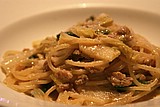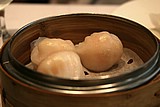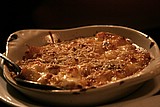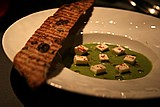Home |
Restaurants by City
|
Food Photography |
Archive | Philosophy |
![]()
Right now we are eating in Seattle, Washington.
|
Monday
2006
Permalink
|
Canoviano, Tokyo, Japan, tasted on December 14, 2005 — I've recounted countless times my love affair with the standards in Japan when it comes to food. The emphasis on freshness, flavor, simplicity and the general high bar makes for a different food world than almost any city on earth (including Paris and New York). And even though before you get to Japan this might not occur to you, the fact remains that those standards remain in place when the Japanese apply themselves to non-Japanese food. One of the cuisines that highlights these same values around freshness, flavor, and simplicity the most is Italian food. And frankly, the best Italian food I've had outside Italy has been in Japan. In fact, in some cases the Italian meals I've had in Tokyo have been better than many of the meals I had in Italy. No restaurant that I know of represents this better than Canoviano in Tokyo. Located next to the Daikonyama subway stop, Canoviano is buried in a smaller residential neighborhood than you might expect. But in Tokyo where space is at a premium it appears they long ago stopped worrying about where the appropriate location for something was. The appropriate location appears to be wherever it will fit. Even though I had been there before, I was worried about finding it. The neighborhood maps at subway stops are always extremely helpful. This restaurant had made quite an impression on me in the past and I felt good coming back. Things felt comfortable and happy. The crusty bread had a soft and dense inside and was placed right on the tablecloth. I couldn't help but make a sizable mess of it and blew the crumbs off the table when nobody was looking. The olive oil for dipping was among the softest, warmest, and roundest flavors I've ever encountered. Silky excellence. Would it be wrong to want to bathe in it? OK. Pretend I didn't say that. That's kind of weird. First up was Cold Cappelini with Raw White Fish and Bottarga. I don't know that this is the right word, but it's the first one that came to mind to describe the flavor - effervescent. There was a fruity sour tomato goodness. The raw fish was soft on the gentle cappelini base. Delicious. So delicate and yet the flavors were super solid. I used to love salads. Even as a kid I ate salads all the time. And yet, the more I got into food, the less I enjoyed most salads. I think this was primarily because salads often felt like an opportunity for the kitchen to throw a bunch of crap together with minimal effort. But in this salad everything was carefully placed. One piece at a time, with everything equally dressed. Water Buffalo Mozzarella and Tomato Salad with Uncured Friuli Ham. Chunks of gorgeous soft mozzarella were peeking out from key spots in the topography of the dish. Delicious. Following the salad I got the Spaghettini with Meat Sauce of Guinea Fowl and Kyoto Vegetables. The poultry was light and golden but with a hearty savory sauce. A sense of warmth and comfort touches my soul when I eat pasta like this. I know it sounds corny, but I'm serious. There's something about al dente pasta with a distinct and perfectly savory sauce makes me super happy. Chunks of meat and yummy vegetables permeated this dish. Super satisfying. Next up was Sautéed White Fish with Vegetables and Sauce. The fish, tachiuo (scabbard fish) had a slight grilled aroma amidst the sea of differently textured vegetables in their subtle turnip soup pond. The soup itself had a super clean flavor. Simple in a good way. The potato (which was Nagaimo, a Japanese Mountain Potato or Long Yam) was crisp and light but not starchy. It was like an apple. Pretty impressive considering that in the past I've not been a nagaimo fan. The range of textures made this dish. That said, I thought sauce could have used a touch more seasoning. This delicate entry was followed by Sautéed Veal loin with Girolle Sauce. The sauce was savory and satiny delicious. The meat tender and juicy. The vegetables encompassed a range of textures. It reminded me of Passard and on how he uses vegetables. Very choosy, careful, and sparing. Excellent. On the rare occasion that I've been lucky enough to travel all the way to Tokyo I really do my best to try as many new places as I can. Canoviano makes it almost impossible for every meal to be new as even though I've eaten there before, I simply can't stop myself from going back. And as special experience as it is, if I lived in Tokyo I could imagine myself eating there once a week. Hopefully I'll be back soon enough to get my fix.
|
|||
Our Sponsors
Free Car Listings – Hot Tubs – Stools – Saunas – Bar Stools - Calendar and Event Schedules - Food Events and Calendars - Wine Events and Calendars - Digital Photography Resources - Software for Advertisers - Jewish Gifts and Judaica - Howard Stern Podcast - ponytailed blogger Jonathan Schwartz

Browse tastingmenu
Home |
Restaurants by City X |
Food Photography |
Archive | Philosophy |
![]()
Free eBooks: All About Apples
| Autumn Omakase
More:
Discussion |
Cool Food T-Shirts |
Ingredients
| Markets |
Recipes
Search |
Blog FAQ |
Other
Blogs
Best of tastingmenu
|
City View
Entry: July 6, 2006 |
Blue Plate
Entry: June 19, 2006 |
L'Atelier de Joël Robuchon
Entry: July 18, 2006 |
Browse by City
Boston | Chicago | Houston | Las Vegas | Los Angeles | Maui | New York | Philadelphia | Portland | San Francisco | Seattle | Toronto | Utah | Vancouver | Washington D.C.
Bangkok | Beijing | Hong Kong | Seoul | Tokyo
Amsterdam | Berlin | Italy | London | Madrid | Paris | Vienna
Browse by Month
2006
2005
2004
2003
2002
2001
Comments, questions, or feedback:
info / at / tastingmenu / dot / com
All pages Copyright (c) 2001-2006 tastingmenu.com
Last modified 01/30/07.





